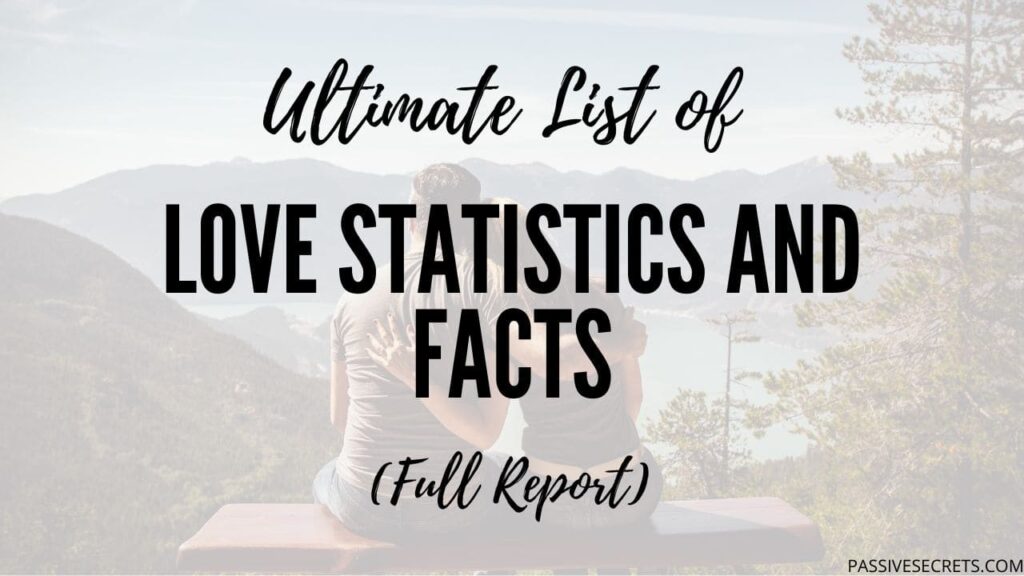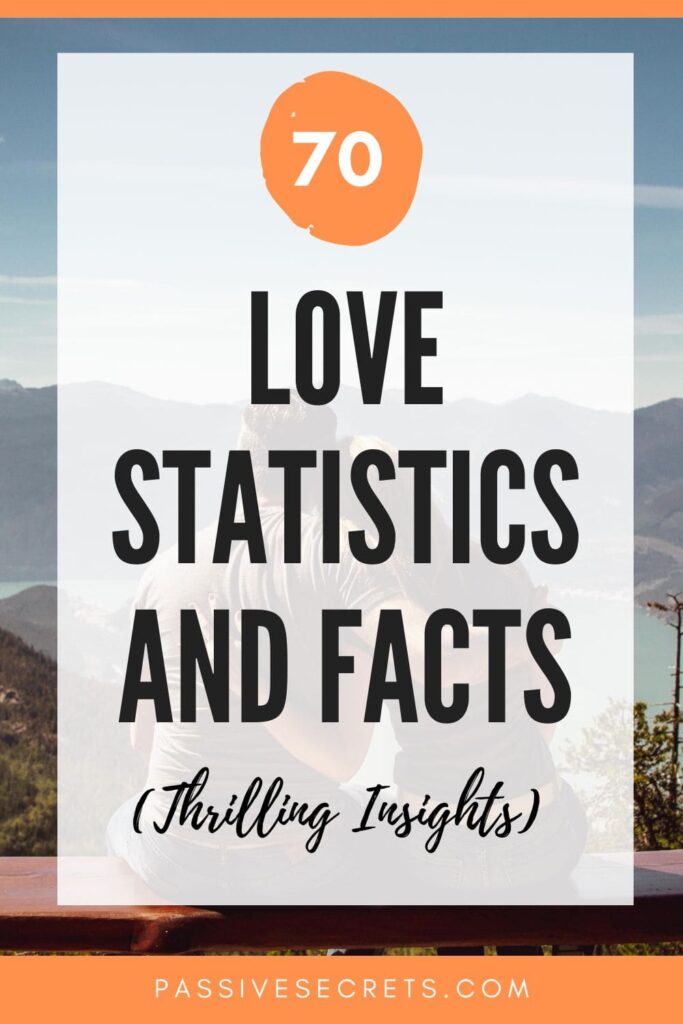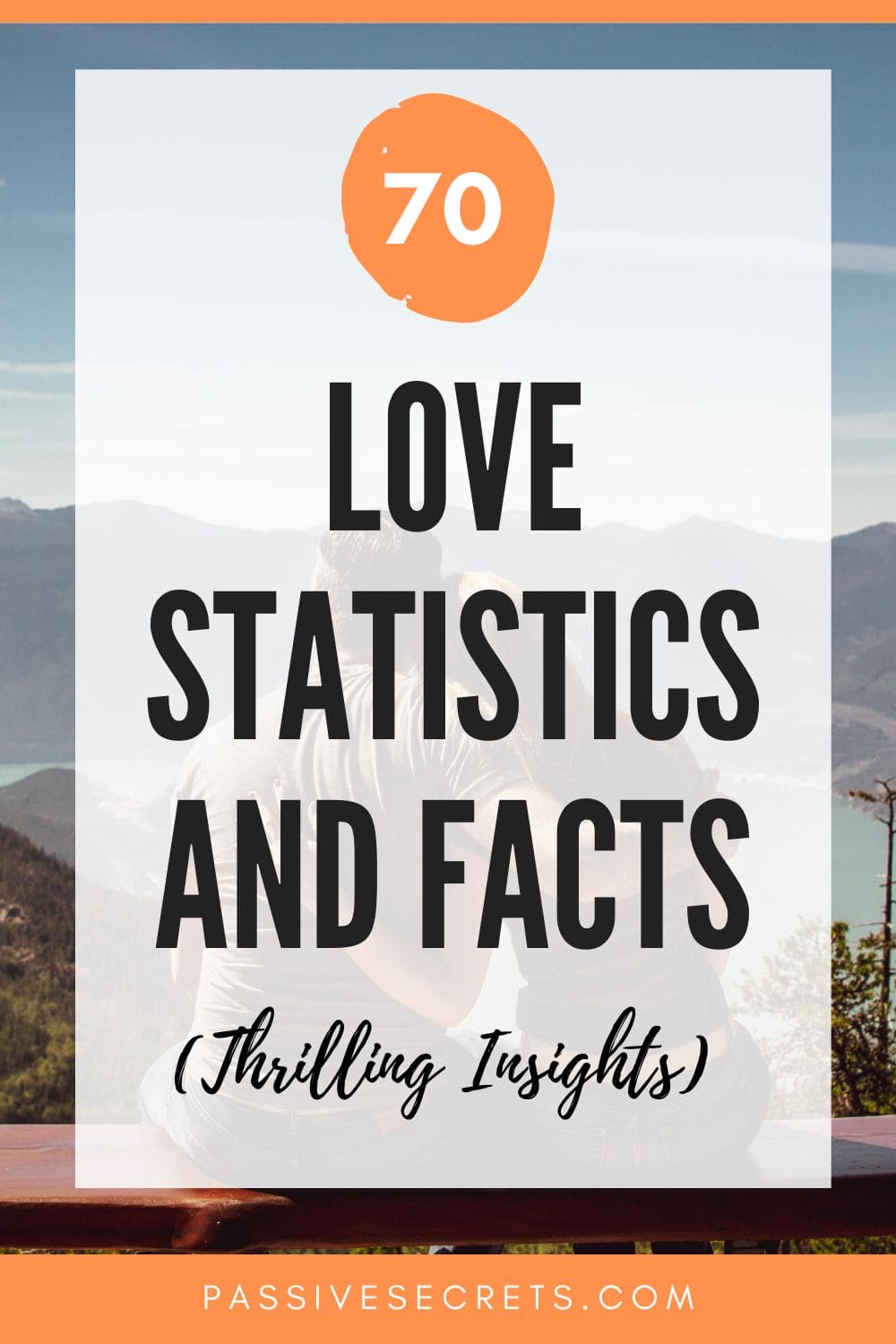
It’s the season of love, and Cupid has been shooting arrows everywhere.
However, as you prepare for the big “V-Day,” you should take a look at some exciting love statistics and facts.
“How do people see love?” “What percentage of relationships last?” “How does love work?”
This post on love statistics answers all those budding questions in your heart and gives you more insight into the world of love.
Disclaimer: As much as I would like to be one, I’m not a love expert. Hence, the figures and facts in this article are purely from other people’s research and study. I gathered them so you can easily see the most exciting statistics on love.
Key Highlights: Love Statistics And Facts
- The Dating Service market will acquire a revenue of $8.10 billion in 2024.
- The number of users in the Dating service market is expected to reach 698.8 million users by 2028.
- 86% of Americans believe that true love exists.
- 60% of divorced/separated couples have experienced true love.
- 94% of people believe in genuine love whether or not they have experienced it.
- Matchmaking is the largest market, with a projected volume of $4.05 billion by 2024.
- The University of York is the top UK university for finding love.
- 57% of Asian adults confess their love to their partners at least once a week.
- Passion, intimacy, and commitment are the three crucial components of love.
- Most people fall in love based on shared similarities or having like minds.
- 94% of women and 88% of men believe in true love.
General Love Statistics
1. The dating service market is projected to acquire a revenue of $8.10 billion in 2024. (source)
2. The Dating market will experience a CAGR of 1.95% between 2024 and 2028, resulting in an estimated market volume of $8.75 billion by 2028. (source)
3. The number of users in the dating service market is expected to reach 698.8 million by 2028. (source)
4. Matchmaking is the largest market, with a projected market volume of $4.05 billion by 2024. (source)
5. The user penetration rate in the Dating Services market is estimated to be 7.7% in 2024. (source)
6. The United States is predicted to generate the highest volume, reaching nearly 3,000 million by 2024. (source)
7. The online dating segment is estimated to achieve the highest value of 452.47 million users. (source)
8. The United States is leading with various platforms for different preferences and demographics in the dating service market. (source)
9. As of 2019, there were around 250 million couples across India. (source)
10. 30% of US adults use an online dating app, and 12% say they have married someone they met via these apps. (source)
Interesting Statistics About Love
11. In Portugal, over 9 out of 10 marriages end in divorce, leading to single parenting. (source)
12. 86% of Americans believe true love exists, while 14% do not. (source)
13. 67% of Americans claim to have been in or experienced true love, while 33% have not. (source)
14. 69% of women are slightly more likely to say they have experienced true love than 64% of men. (source)
15. 56% of American adults between the ages of 18-29 say they have experienced true love, and 65% of adults aged 30-44 claim to have experienced true love. (source)
16. 69% of American adults aged 45-64 claim to have experienced true love, and 75% of American adults aged 65+ have experienced true love. This shows the more advanced a person is in age, the more likely he is to find or experience love. (source)
17. 85% of married couples in America admitted to having experienced true love, while 15% say they have not. (source)
18. 60% of divorced/separated couples have experienced true love, while 40% claim to have not. (source)
19. 18% of US people believe they have found true love. (source)
20. 43% of American adults claimed to have experienced true love, while 57% said they had never experienced anything like this. (source)
21. 31% of US adults believe true love doesn’t exist. (source)
22. 94% of people believe in genuine love whether or not they have experienced it. (source)
23. In a survey, 64% of Americans say they are happy with their relationships. However, 19% said they are unhappy to some extent. And 6% said they are “desperately unhappy” in their relationship. (source)
24. Almost eight in ten say they married because they were in love. (source)
Astonishing Love Statistics
25. 48.1% of people believe that it is possible to be in love with more than two people at the same time. (source)
26. 61% of romance novels make love look easier to attain than it is, while 26% make it harder to acquire. Only 13% of romance novels present love as it truly is. (source)
27. One in five people aged 50-64 met their partner by chance at the bar or any other social gathering. (source)
28. Only 11% of people met their partners on a website, while 7% met their partners in more unusual ways. (source)
29. 40% of surveyed U.S. respondents say romance is vital to them in a relationship, and they can’t feel loved without it. (source)
30. A survey found that 59% of men and 65% of women in Germany are interested in information about relationships and being a couple. (source)
31. Falling in love resulted in immune system changes that are similar to protecting viral infection responses. (source)
32. Love is an emotion that can easily be regulated by simply generating new feelings or reducing the intensity of the old feelings. Feelings can be suppressed through certain distractions, expression suppression, situation selection, etc. (source)
33. In a recent survey, the University of York is the top UK university for finding love. 63.30% of students at the University of York said they met a romantic partner while there. Unfortunately, the majority of these connections did not last, with only 7.34% stating they were married to the partner they met in university. (source)
34. The University of Manchester follows closely, as 61.74% of surveyed students said they found love while studying there. (source)
35. However, in the same survey, the University of Aberdeen is considered the worst university to find love. Only 6.40% of students say they found love while studying there. Also, only 8% of the people who found love in the university married their partner. (source)
36. In all, only one in 3 (35.63%) UK university students find love in school. And only 12.17% of those relationships lead to marriage. (source)
37. In Singapore, 83% of citizens are happy with their relationship with their spouse or partner. Men are more likely to feel this way, with 89% claiming satisfaction compared to 75% of women. (source)
38. 75% of Singaporeans (78% of men, 72% of women) say they are satisfied when it comes to feeling loved. But fewer say they are happy with their romantic or sex life. (source)
39. In the Asia Pacific, Indonesia comes out as the country with citizens most satisfied in their relationships. 94% of citizens say they are delighted. 90% of Thailand citizens say the same. However, only 73% and 70% said the same for Korea and Japan, respectively. (source)
40. 63% of surveyed Asians agree that laughter is an essential part of a relationship. (source)
41. In Asia, 57% of adults confess their love to their partners at least once a week. (source)
Dating Apps Statistics For Love Matching
42. In July 2023, Tinder, the most popular dating app in the world, was downloaded by 6 million people. (source)
43. 24% of single internet users would be more interested in online dating if online game arrangements were in place. While 13% of singles claimed that they would still be uninterested. (source)
44. 39% of heterosexual couples met their significant other online, compared to 22% in 2009. (source)
45. Only 1 in 20 people aged 20-29 met their partner in a bar or anywhere. (source)
46. 21% of millennials between the ages of 25-34 years old claimed to have met their partners online; 13% were through dating apps, and the other 9% were through the use of dating sites. (source)
47. 5% of adults in the US currently use online dating apps or sites. (source)
48. 21% of adults in the US are not currently using their online apps or sites but have done so in the past year. (source)
49. The most popular online dating site in April 2022 was Badoo.com, which had about 105.73 million visits. Tinder.com was the next most popular online dating site, with about 94.96 million visits. (source)
50. 31% of millennial dating app users in the US were using online dating apps or services much more after the COVID-19 pandemic than before. (source)
51. 15% of male internet users used the Grindr online dating app as of January 2018. (source)
52. 17% of male internet users were using Tinder as of April 2020, while only 7% of female internet users used Tinder. (source)
53. 10% of male internet users were using Bumble as of April 2020, while only 6% of females confirmed being users of the social dating app. (source)
54. In the United Kingdom, 15.5% of internet users between the ages of 25 and 34 used online dating services. Also, over 14% of users between the ages of 35 and 44 used online dating services during the same time period. Approximately 10% of users aged 45 and up reported using online dating websites and mobile apps. (source)
Facts About Love
55. Research has shown that men say “I Love You” before women do. (source)
56. Healthy communication among couples is a guaranteed way to strengthen relationships. (source)
57. Maintaining eye contact between couples can help to strengthen their relationship. (source)
58. The release of a neurotransmitter called “dopamine” increases feelings of pleasure associated with romantic love. This hormone is what makes people fall in love. (source)
59. The release of a neurotransmitter called “oxytocin” increases the connection people form with their partners. This hormone is what makes sex enjoyable. (source)
60. Breaking up with someone you love resembles kicking an addiction. It comes in 7 stages: shock, denial, isolation, anger, bargaining, depression, and acceptance. (source)
61. Erotomania is a condition whereby a person falsely believes that someone else is in love with them. Unfortunately, they are not. Erotomania is also known as delusional love and can be dangerous if not handled with care. (source)
62. Passion, intimacy, and commitment are the three important components of love. (source)
63. In the early stages of love, people’s cognitive control declines, reflecting on their productivity level. (source)
64. People who have felt love before have a significantly higher level of psychological well-being. This includes the feelings of purpose and optimism. (source)
65. Most people fall in love based on shared similarities or having like minds. (source)
66. Kissing every morning is said to increase a couple’s life span by five years. (source)
67. There are eight types of love (source). They include:
- Eros (passionate love)
- Pragma (Enduring love)
- Ludus (Playful love)
- Agape (Universal love)
- Philia (Deep friendship)
- Philautia (Self-love),
- Storge (Familial love)
- Mania (Obsessive love)
68. The fourth finger is said to connect directly to the heart through a vein called “the vein of love.” This is why people place engagement rings on the fourth finger. (source)
69. There are four love languages — Words of Affirmation, Quality Time, Physical Touch, Acts of Service, and Receiving Gifts. (source)
70. A study shows that 94% of women and 88% of men believe in true love. (source)
Final Thoughts
Love can have a wide range of benefits for people’s physical and mental health.
It has been seen to reduce stress, boost the immune system, improve cardiovascular health, and even increase lifespan.
Love makes people happier, more fulfilled, and more satisfied. It has a profound impact on people’s lives and can positively affect their physical and mental well-being.
However, being in love can lead to less rational decision-making, as people may be more likely to make decisions based on emotions rather than logic.
Breakups and other relationship problems can also lead to short and long-term health problems. This means that since love can be very beneficial, it’s essential to be aware of the potential risks as well.
Frequently Asked Questions
1. What Percentage of People Find Love?
67% of people would find love and have experienced love before.
2. How Many People Believe in True Love?
86% of people believe in true love.
3. What is the Deepest Form of Love?
Based on research, the deepest form of love is Agape love. This is because it is unconditional and selfless. However, this is quite relative because deep love can mean different things to different people.
4. What is Stenberg’s Triangular Theory on Love?
According to Psychologist Robert Stenberg, love has three components: passion, emotional intimacy, and commitment. These components form the “triangle of love.”
5. How Many Online Daters Are There in the World?
In 2022, there were over 366 million online dating service users. The figure is expected to reach about 440 million people by 2027.
6. How Many Times Does a Person Fall in True Love?
An average person would fall in love at least three times in their lives.
7. Where do Most People Find Their True Love?
Millennials are most likely to find love online through dating apps. People can also find love in other social gatherings, but since the COVID-19 pandemic, more people have found love online than at social gatherings.

Other Statistics Posts:
- 25+ Best Emotional Intelligence Statistics to Know in 2024
- 50+ Latest Life Coaching Statistics and Trends in 2024
- 45+ Important Communication Skills Statistics & Trends for 2024
- 40+ Useful Procrastination Statistics To Help You In 2024
- 54 Incredible Goal-Setting Statistics To Help You In 2024
- 54 Insightful Call Center Statistics for 2024
- 40+ Top Workplace Conflict Statistics You Should Know In 2024
- 47+ Important 4-day Work Week Statistics [2024]
- 73 Revealing Workplace Distraction Statistics [2024]
- 68 Performance Management Statistics & Trends in 2024 (Full Report)
- 20 Crucial Body Language Statistics To Know In 2024
- 35 Important Public Speaking Statistics To Help You in 2024
- 36 Interesting Social Worker Burnout Statistics for 2024
- 65+ Impressive Chess Statistics and Facts To Know in 2024
- 160 Holiday Spending Statistics 2024: Valentine’s Day, Easter, Thanksgiving, and Christmas
- Video Game Addiction Statistics
Marketing-related Statistics Posts:
- 41+ Latest Multichannel Marketing Statistics and Trends
- 81+Sales Funnel Statistics To Increase Conversion Rates (Complete List)
- 71 Important Workplace Communication Statistics To Know in 2024
- 67+ Best Virtual Event Statistics & Benchmarks All Marketers Need to Know in 2024
- 47+ Top Multi-level And Network Marketing Statistics, Facts & Trends
- 55 Useful Direct Mail Marketing Statistics, Trends, and FAQs For 2024
- 75 Pay-Per-Click Statistics, Trends & Benchmarks (Amazon, Social, Google & Search Ads Stats)
- 45+ Useful Omnichannel Marketing Statistics, Data, Trends, & Strategies to Boost Sales Results
- 50 Trade Show Statistics and Trends to Boost Your Business in 2024 and Beyond
- 55 Teamwork & Workplace Collaboration Statistics To Boost Your Employee Performance
- 110+ Important Social Media Advertising Statistics & Trends To Help You in 2024
- 61+ Useful Podcast Advertising Statistics & Trends To Help You in 2024
- 55+ Top Black Consumer Spending Statistics (2024 Report)
- 50 Crucial Amazon Advertising Statistics, Trends & Strategies for 2024 and Beyond
- 41+ Best Copywriting Statistics & Trends to Help You in 2024 And Beyond
- 50 Useful Organic Vs. Paid Search Statistics To Know in 2024
- 100+ Top Digital Marketing Vs. Traditional Marketing Statistics To Know in 2024

